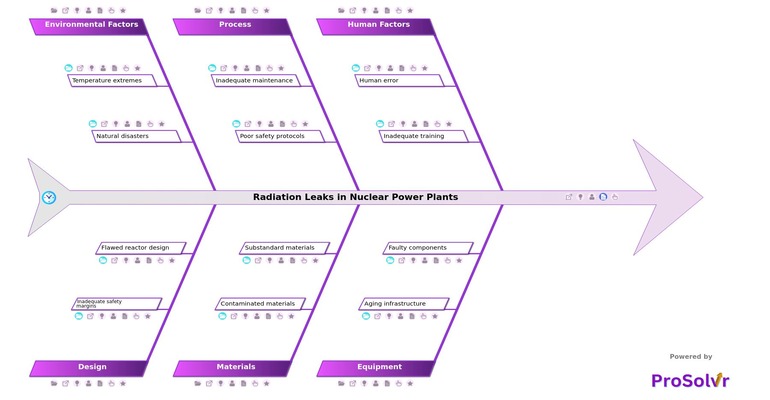RCA of Radiation Leaks in Nuclear Power Plants
Using a fishbone template, also known as an Ishikawa diagram, for root cause analysis (RCA) of radiation leaks in a nuclear power plant is crucial for systematically identifying and addressing underlying issues. This visual tool helps categorize potential causes of problems into key segments, ensuring a comprehensive examination of all factors contributing to radiation leaks. By organizing potential causes in a structured manner, stakeholders can prevent oversight and enable thorough problem-solving.
The Ishikawa template, incorporating Six Sigma principles, fosters collaborative analysis among multidisciplinary teams within the nuclear power plant. It encourages robust discussions where experts from various fields contribute their knowledge and insights. This collaborative approach ensures diverse perspectives are considered, leading to prompt corrective and preventive actions.
In high-stakes environments like nuclear power plants, where safety and precision are paramount, thoroughness is essential for mitigating risks and enhancing operational safety. The consequences of radiation leaks can be catastrophic, and the clarity and precision provided by the fishbone template are indispensable for maintaining safety and regulatory compliance.
In conclusion, utilizing a fishbone template, or Ishikawa diagram, for root cause analysis (RCA) of radiation leaks in a nuclear power plant is an essential practice for ensuring operational safety and regulatory compliance. By fostering collaborative analysis through the incorporation of Six Sigma principles, the Ishikawa template facilitates robust discussions among multidisciplinary teams. This systematic and visual approach categorizes potential causes into key segments, providing a comprehensive examination of all contributing factors.
Who can use the Radiation Leaks Template?
- Safety and Compliance Teams: Responsible for ensuring that the plant operates within regulatory guidelines and safety standards, these teams can use the fishbone template to systematically identify and address potential causes of radiation leaks, ensuring compliance with safety regulations and minimizing risks.
- Engineers and Technical Staff: Nuclear, mechanical, and electrical engineers can use the fishbone diagram to analyze technical aspects and equipment-related issues contributing to radiation leaks. This tool helps pinpoint specific mechanical failures or design flaws that need attention.
- Operations and Maintenance Teams: Directly involved in the day-to-day functioning and upkeep of the plant, these teams can identify procedural errors, maintenance lapses, or operational inefficiencies that could lead to radiation leaks. This enables them to implement corrective measures and improve operational protocols.
- Management and Decision-Makers: Plant managers and decision-makers can use the fishbone analysis to understand the root causes of radiation leaks from a high-level perspective. This understanding helps make informed decisions regarding resource allocation, policy changes, and strategic planning to enhance overall plant safety.
- Regulatory and Inspection Authorities: External auditors and inspectors from regulatory bodies can use the template to review and assess the plant’s root cause analysis efforts. This ensures that investigations are thorough and meet regulatory standards, enhancing accountability and transparency.
Why use Radiation Leaks Template?
- Employing a Gen-AI powered RCA facilitates clear communication and documentation of the investigation process. The visual representation of root cause analysis tools like ProSolvr helps in determining potential causes and presenting findings to all stakeholders, including regulatory bodies, management, and operational staff. This transparency is vital for building trust and ensuring that corrective actions are understood and implemented effectively.
Draft and create a template for problem analysis in ProSolvr by smartQED.








